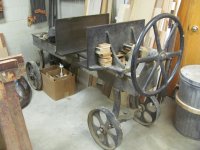Stan Tillinghast
Member
- Joined
- Mar 18, 2007
- Messages
- 309
I am planning on building replacement bathroom cabinets from pre-finished maple plywood.
This will be my first build of conventional cabinets. They will be Euro style, using the LR32 system for hinge holes and shelf pin holes.
I've just watched (again) Greg Paolini's video of cabinet building, and Brett Shiveley's Festool video series on cabinets.
I have all the tools needed to do Domino or pocket-hole joints, and step bits for Confirmat screws; also I have an as-yet unused Milwaukee 23 gauge pin nailer I can use to tack the parts together.
It seems to me that for these cabinets, where all ends will be hidden, that dominoes are overkill and screws, such as Greg Paolini uses, would be more than adequate. I know confirmat screws are recommended for MDF, but are not bugle-head GRK screws fine for assembly of plywood cabinets (#8 x 2 inch?)
I haven't yet tried using the GRK screws without pre-drilling; I can try and see if that seems to produce a neat result.
This will be my first build of conventional cabinets. They will be Euro style, using the LR32 system for hinge holes and shelf pin holes.
I've just watched (again) Greg Paolini's video of cabinet building, and Brett Shiveley's Festool video series on cabinets.
I have all the tools needed to do Domino or pocket-hole joints, and step bits for Confirmat screws; also I have an as-yet unused Milwaukee 23 gauge pin nailer I can use to tack the parts together.
It seems to me that for these cabinets, where all ends will be hidden, that dominoes are overkill and screws, such as Greg Paolini uses, would be more than adequate. I know confirmat screws are recommended for MDF, but are not bugle-head GRK screws fine for assembly of plywood cabinets (#8 x 2 inch?)
I haven't yet tried using the GRK screws without pre-drilling; I can try and see if that seems to produce a neat result.


